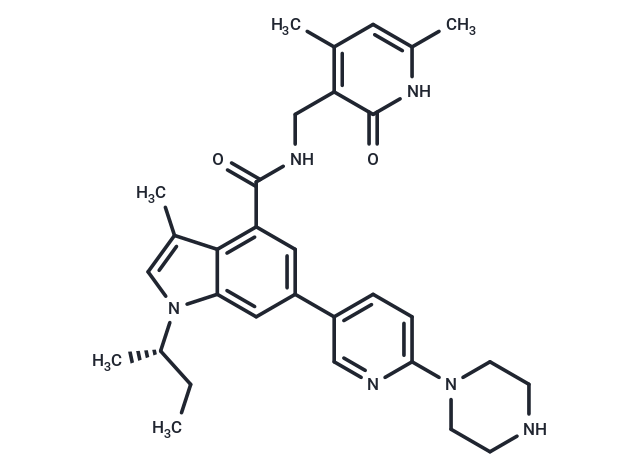Shopping Cart
- Remove All
 Your shopping cart is currently empty
Your shopping cart is currently empty

GSK126 (GSK2816126A) is a excellently specific EZH2 methyltransferase inhibitor ( IC50=9.9 nM).

| Pack Size | Price | Availability | Quantity |
|---|---|---|---|
| 2 mg | $37 | In Stock | |
| 5 mg | $59 | In Stock | |
| 10 mg | $90 | In Stock | |
| 25 mg | $154 | In Stock | |
| 50 mg | $239 | In Stock | |
| 100 mg | $368 | In Stock | |
| 200 mg | $479 | In Stock | |
| 1 mL x 10 mM (in DMSO) | $68 | In Stock |
| Description | GSK126 (GSK2816126A) is a excellently specific EZH2 methyltransferase inhibitor ( IC50=9.9 nM). |
| Targets&IC50 | EZH2:9.9 nM |
| In vitro | In mice bearing human B-cell lymphoma cells and human diffuse large B-cell xenografts, treatment with GSK126 (150 mg/kg/d, i.p.) led to a reduction in H3K27me3, thereby inhibiting tumor cell proliferation. |
| In vivo | In both EZH2 wild-type and mutant DLBCL cell lines, GSK126 effectively inhibits H3K27me3 and H3K27me2, consequently suppressing cell proliferation. In parental H2087 cells, GSK126 curtails cell proliferation, migration, and metastasis by downregulating the expression of VEGF-A and phosphorylated Ser(473)-AKT. In A687V EZH2 mutant cells, GSK126 reduces H3K27me3 levels, leading to the inhibition of cell proliferation. |
| Kinase Assay | EZH2 assay: The five-member PRC2 complex (Flag–EZH2, EED, SUZ12, AEBP2, RbAp48) containing either wild-type or mutant EZH2 is prepared. GSK126 is dissolved in DMSO and tested at concentrations of 0.6?nM to 300?nM with a final DMSO concentration of 2.5%. In contrast to wild-type EZH2 which prefers H3K27me0 as a substrate in vitro, EZH2 Y641 mutants prefer H3K27me2 and have little activity with H3K27me0 or H3K27me1. The A677 g mutant is distinct from both the wild-type and Y641 mutant forms of EZH2 in that it efficiently methylates H3K27me0, H3K27me1, and H3K27me2; therefore, histone H3 peptides (residues 21–44; 10?μM final) with either K27me0 (wild type, A677 g EZH2), K27me1 (A677 g EZH2), or K27me2 (A677 g, Y641N, Y641C, Y641H, Y641S and Y641F EZH2) are used as methyltransferase substrates. GSK126 is added to plates followed by addition of 6?nM EZH2 complex and peptide. As the potency of GSK126 is at or near the tight binding limit of an assay run at [SAM] = Km, IC50 values are measured at a high concentration of the competitive substrate SAM relative to its Km (7.5 μM SAM where the SAM Km is 0.3?μM). Under these conditions, the contribution from the enzyme concentration becomes relatively small and accurate estimates of Ki can be calculated. Reactions are initiated with [3H]-SAM, incubated for 30 min, quenched with the addition of 500-fold excess unlabelled SAM, and the methylated product peptide is captured on phosphocellulose filters according to the vendor supplied protocol for MSPH Multiscreen plates. Plates are read on a TopCount after adding 20?μL of Microscint-20 cocktail. Apparent Ki values are calculated using the Cheng–Prusoff relationship for a competitive inhibitor. IC50=Ki (1+[S]/Km)+[E]/2, where E is the enzyme and S is the substrate. |
| Cell Research | The optimal cell seeding is determined empirically for all cell lines by examining the growth of a wide range of seeding densities in a 384-well format to identify conditions that permitted proliferation for 6?days. Cells are then plated at the optimal seeding density 24 h before treatment (in duplicate) with a 20-point two fold dilution series of GSK126 or 0.15% DMSO. Plates are incubated for 6?days at 37°C in 5% CO2. Cells are then lysed with CellTiter-Glo (CTG) and chemiluminescent signal is detected with a TECAN Safire2 microplate reader. In addition, an untreated plate of cells is harvested at the time of compound addition (T0) to quantify the starting number of cells. CTG values obtained after the 6?day treatment are expressed as a percent of the T0 value and plotted against compound concentration. Data are fit with a four-parameter equation to generate a concentration response curve and the concentration of GSK126 required to inhibit 50% of growth (growth IC50) is determined.(Only for Reference) |
| Alias | GSK2816126A, EZH2 inhibitor |
| Molecular Weight | 526.67 |
| Formula | C31H38N6O2 |
| Cas No. | 1346574-57-9 |
| Smiles | CC[C@H](C)n1cc(C)c2c(cc(cc12)-c1ccc(nc1)N1CCNCC1)C(=O)NCc1c(C)cc(C)[nH]c1=O |
| Relative Density. | 1.25 g/cm3 (Predicted) |
| Storage | store at low temperature,keep away from direct sunlight | Powder: -20°C for 3 years | In solvent: -80°C for 1 year | Shipping with blue ice. | ||||||||||||||||||||
| Solubility Information | 10% DMSO+40% PEG300+5% Tween 80+45% Saline: 0.53 mg/mL (1.01 mM), In vivo: Please add the solvents sequentially, clarifying the solution as much as possible before adding the next one. Dissolve by heating and/or sonication if necessary. Working solution is recommended to be prepared and used immediately. DMSO: 10.63 mg/mL (20.18 mM), Sonication is recommended. | ||||||||||||||||||||
Solution Preparation Table | |||||||||||||||||||||
DMSO
| |||||||||||||||||||||

Copyright © 2015-2025 TargetMol Chemicals Inc. All Rights Reserved.